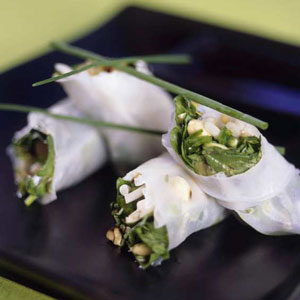For centuries, Vietnam had been washed over by Chinese, Thai, Indian,
French, Russian, and American influences, creating the ultimate
“fusion” food. Vietnamese food isn’t as spicy as Thai and, unlike
Chinese, there’s little soy sauce or stir-frying. It’s a light,
relatively uncomplicated cooking full of simple fresh flavours.
Travellers to Vietnam might be horrified by local ingredients,
pangolin, python, gecko and bat, not to mention ‘man’s best friend’,
all make it to the menu, but because Mahayana Buddhist monks in Vietnam
are largely vegetarian, there’s a myriad of veggie alternatives.
Vietnamese
cuisine varies from the simple north, the sophisticated centre, and the
spicy south. Most of us would have eaten southern-style food, with its
wide variety of fresh herbs and tropical flavours. Food from the centre
tends to have more chilli heat, and shrimp paste is used extensively.
Up north, the food has more of a Chinese feel, with greater use of
preserved vegetables, tree fungus, and dried mushrooms, and fewer fresh
herbs and greens. There are also more stir fries, and black pepper is
used instead of chillies.
In the north and south breakfast is often a large bowl of pho
(hot soup), filled with noodles, bean sprouts, sprigs of fresh herbs
and lean pieces of chicken, pork or beef. The soup will be garnished
with more fresh herbs or sprouts from the table salad, or with any of
the many condiments and dipping sauces on the table. In rural areas xoi, sticky rice steamed in a leaf wrapper, sometimes mixed with peanuts or mung beans, is what breakfast is all about.
Most cooking is done in a wok or steamer but a large, deep pan can also
be used. Typical Vietnamese ingredients include bamboo shoots, that can
be bought in cans; dried shrimp paste, a strong fermented fish paste
used to add saltiness and body to dishes; cellophane noodles, made from
mung beans and that need to be soaked before cooking; Bahn pho noodles, which are flat noodles made from rice flour; Nuoc mam, a sauce made from fermented fish and used to add saltiness and which has virtually replaced soy sauce, and Bahn trang,
an edible rice paper wrapper used to make spring rolls. Popular herbs
and fresh flavourings are fresh coriander, mint, lemon grass, garlic,
ginger, spring onions, basil, fennel, dill and assorted vegetables and
lettuce.
Another typical dish is minced prawn and pork placed on sugar cane and
grilled over coals. Seafood (squid, shrimp) and meat are often mixed in
this way, up to four different meats may be used in one dish. A meal
should look as good as it tastes and for this purpose fresh vegetables
are sliced, chopped or carved for garnishes. Herbs wrapped in the
slightly transparent rice paper also create an attractive garnish.
Vegetarian dishes include pickled vegetables, vegetable spring rolls,
rice and noodles, and a variety of dishes wherein tofu and other bean
curd products replace meat.
All meals are accompanied by a table salad of assorted fresh herbs,
salad greens, sprouts and pickled vegetables and an array of dipping
sauces, pickles, flavourings, and garnishes. Speaking of sauces,
Vietnamese dipping and flavouring sauces are varied and wonderful. The
most common is nuoc cham,
a pale blend of salty, pungent fish sauce diluted with fresh lime juice
and sometimes vinegar, spiced with garlic and chopped chillies, and
sweetened with a touch of sugar. You can drizzle it over rice, use it
as a dip for spring rolls or grilled meats or add a spoonful to your
soup. Other dipping sauces are a peanut sauce (nuoc leo), a red-hot chilli sauce (tuong ot) and a pungent shrimp sauce (mam tom).
One distinct feature of Vietnamese cuisine is the do-it-yourself method
of eating. Mealtimes are spent picking and choosing from what’s on the
table, wrapping it in lettuce or rice paper and dipping in a sauce.
Simply lay a fresh or moist rice paper wrapper or shred of lettuce on
your open palm, put in a piece of meat, grilled chunks of lemongrass
beef, grilled meatballs or freshly steamed shrimp, a couple of strips
of pickled radish, some herbs if you like, sprouts or rice vermicelli,
then tuck over the ends and roll it up. It creates a fresh spring roll
that can be dipped in Nuoc Cham.
Finally, Vietnamese love condensed milk, adding it to desserts and to
hot and cold drinks. Fruit-based custards, banana fritters and
ice-creams are also popular desserts. Tea is consumed morning to night,
served before or after but never during a meal. They also like their
coffee black, strong, hot or iced, but almost always with condensed
milk. Other drinks include freshly pressed sugarcane juice, salty
watermelon juice or Vietnamese beer.
Chuc an ngon!
8 things to do with Vietnamese cuisine
Chilled Vietnamese noodle salad
Stir-fried lamb with bean sprouts and ginger
Vietnamese crab and chicken spring rolls
Grilled line fish with lemon grass sauce

